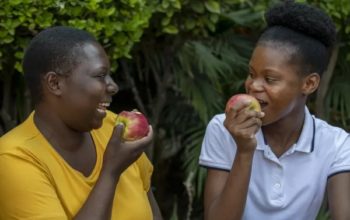The noise and air pollution from the mine increased the children’s risk to exposure to diseases

By Marcia Zali
“Relieved and happier”
These are some of the words used by teachers to describe children from an early childhood development (ECD) centre near Somkhele coal mine, Kwa-Zulu Natal.
Although the relief might be temporary, the teachers said that the temporary suspension of operations at the mine has brought back some “normalcy” for them and the children.
The suspension follows a High Court finding in May this year, that the scoping or Environmental Impact Assessment (EIA) by Somkhele mine was unlawful, there was no consent in terms of the Interim Protection of Informal Land Rights Act and that the public participation process was defective.
Before then, the 56 children aged between 0 to 5 years old were struggling to concentrate during their lessons and activities because of the noise and vibrations coming from the mine.
Formed in the year 2000, the ECD centre that cannot be named, was once a safe space for children from the rural communities within the Mtubatuba area.
Changed environment
The environment changed when the mine started operating in 2007, resulting in legal battles between the communities and the mine as well as conflict amongst neighbours who are either supporting the expansion of the mine or are opposing it.
A teacher who asked not to be named said that children were not spared from the effects of mining operations in their community, especially the environmental effects that seemed “normal” to them..
She also added that since the killing of vocal anti-mining activist, Fikile Ntshangase, and acts of intimidation against those who spoke against the mine, they were afraid to speak openly on issues related to it [mine].
“Since the mine came, things have changed a lot. We had to monitor the children more than we did before because they would sometimes pick up debris that got scattered all over after blasting activities,” she added.
Even though the aftermath of the blasting activities was a concern, it was the reaction of the children before and during the blastings that the teachers were more concerned about.
For the children’s safety, the teachers had gotten used to preparing them mentally before the blasting could happen.
Preparations for the traumatic and confusing activities would start the day before when an official from the mine would come to inform them that there was a scheduled blasting activity for the following day.
This always made the teachers anxious because they had seen how the children reacted to the loud noise, tremors and not being able to play outside.
“First you will hear the siren alerting us that the blasting is about to start and then the mayhem starts. Then there will be a huge explosion which makes the ground shake, followed by a huge cloud of smoke and dust,” said the teacher.
She added that, “Some of the children just freeze and others start crying. We try to calm them down until the noise is gone. We also do not allow them to play outside on that day because there will be a lot of dust and everything just looks black.”
Health concerns
Although the children are not showing signs of having any airborne diseases like tuberculosis (TB), the teacher said she was concerned about the dust that has contaminated the water in the area and turned the houses black, affecting the children’s health.
The 2019 Child Gauge wrote that a study on school children in Durban found that children from industrial communities were more likely to experience respiratory problems such as asthma.
“Air pollution in South Africa also increases health-care costs, especially for children who may develop chronic respiratory effects or have to be hospitalised with acute asthma attacks.”
It further stated that South African children were exposed to air pollution inside and outside of the home. This put the children at a high risk of exposure to diseases because they were vulnerable at different developmental stages.
Non-communicable diseases (NCDs) like respiratory diseases, cancers, neurodevelopmental disorders, type 2 diabetes, reproductive diseases, malnutrition, endocrine disruption and obesity that are linked to exposure to environmental hazards were increasing.
According to the gauge, the World Health Organisation estimated that in South Africa, 124 out of every 100,000 deaths of children under five are linked to the environment, and environmental birth defects are increasing.
The WHO on the other hand, in 2018 reported that 93% of all children live in environments with air pollution levels above the WHO guidelines.
According to the report, more than one in every four deaths of children under 5 years of age is directly or indirectly related to environmental risks.
Both ambient air pollution and household air pollution contribute to respiratory tract infections that resulted in 543 000 deaths in children under the age of 5 years in 2016.
The Indian Pediatrics reported in 2016 that exposure to noise during pregnancy may result in high-frequency hearing loss in newborns, growth retardation, cochlear damage, prematurity and birth defects.
Newborns exposed to sound above 45 decibels may experience increase in blood pressure, heart rate, respiratory rate; decreased oxygen saturation; and increased caloric consumption, said the study.
It further added that noise exposure in older children may result in learning disabilities, attention difficulties, insulin resistance, hypertension, stress ulcers and cardiovascular diseases.
The nurturing care framework focuses on promoting clean and safe environments for children. This includes ensuring that children are protected from noise pollution, air pollution and lead exposure.
Advancing healthier environments is also seen as an opportunity to children’s health, wellbeing and development. It is also essential in achieving the Sustainable Development Goal (SDG) which seeks to reduce the number of deaths and illnesses from hazardous chemicals and air, water and soil pollution and contamination by 2030.
Children feel unsafe

While the children at the ECD centre were born into the current environment a teenage girl who is in high school and asked not to be named said that the mine had brought so much distraction in the once peaceful village of Ophondweni.
The teenager is one of the children whose life was directly impacted by the violence that happened as a result of the mine’s presence. She had to stop living with her family to keep another relative company at night.
“Our village is not safe anymore. Our neighbours and relatives have been attacked and killed so we also do not feel safe. I wish the mine would be closed because nothing good has come from it. People are unemployed, there are no parks for children to play and there are no proper roads,” she said.
Meanwhile, the Department of Social Development (DSD) in the province said it had not been approached to intervene on any of the challenges facing children in the community.
The department would also not comment on the environmental challenges of noise and air pollution that had affected teaching and learning at the ECD centre, stating that the Department of Basic Education was now responsible for ECDs.
“The Department of Social Development has a responsibility to ensure the protection of children at all times. Therefore, parents have a right to contact the Department to intervene when they see anything that poses danger to their children,” explained the provincial spokesperson, Mhlabunzima Memela.
‘This story was made possible with support from the Internews’ INSPIRES project’




